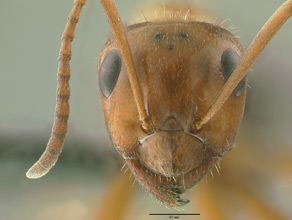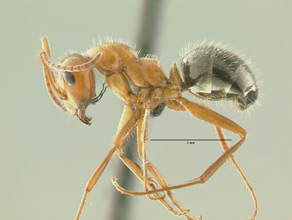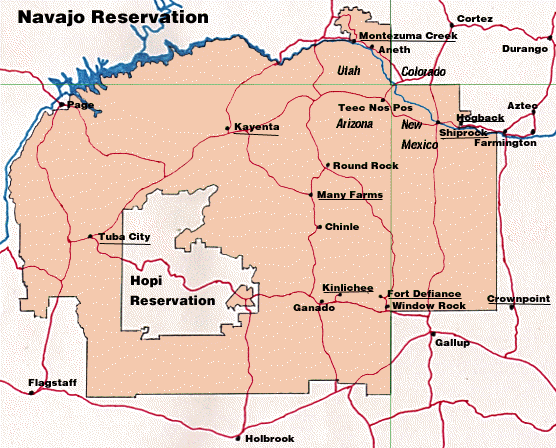- Identification
- Slightly polymorphic workers that range from smaller than medium-sized to medium sized. Their shiny integument and small size place these Formica ants in the neogagates species group. Formica perpilosa can be separated from other Navajo Reservation neogagates species by the presence of a notch on the anterior edge of their clypeus and an abundance of white erect hairs on the body (gaster, mesosoma and head). Workers have a black or dark brown gaster with a lighter colored yellow-brown body. The head may be dark, like the gaster, or lighter colored.
- Biology
- Formica perpilosa can be found in desert areas, and other dry habitats, but favors nesting in microsites that are slightly moister than average e.g., in shaded locations or along the edge of seasonal washes. Colonies can also be found along the berms of roads in some southwestern US locales. Nest entrances may be located at the base of root, or may be marked by a flattened mound or crater.
- additional biology notes...
- Distribution
- Range
- United States - southwest and western portion of the midwest. Mexico.
- Navajo Reservation Records
- Collection records being processed.
- Additional Notes
- Workers of Formica perpilosa are polymorphic. A study examining the behavior of a colony's workforce found that the smaller workers performed a majority of the tasks, and work, within a nest (Brandão 1979). The small proportion of major workers (6% of the workforce) were primarily serving as a food storage caste, leading to the suggestion that this is an example of an early precursor to the development of true repletes like that found in the species Myrmecocystus mexicanus.
- Foraging
- Foraging ants actively search on vegetation and the ground, collecting both honeydew and dead insects. Formica perpilosa's ability to tolerate hot, dry habitats is enhanced by their foraging upon plants. Workers are able to be active outside the nest during the day, at least where there is direct (i.e. a nest entrance at the base of a plant) or shaded access to a plant, despite what may be lethal temperatures on the ground surface (Schumacher and Whitford, 1974). A meter above the ground, within the shaded canopy of a large shrub, daytime temperatures can be 15 - 25 degrees cooler than the ground surface.
- Desiccation resistance in Formica perpilosa is not unusually high. For workers foraging for exudates from insects on plants the collection of liquid food resources likely allows them to better tolerate dry conditions while outside the nest (Whitford et. al 1975).
- Forager populations in mature nests were estimated to be between 2,000 and 3,500 individuals (Schumacher and Whitford, 1974).
- Association with Butterfly Larvae
- Formica perpilosa are known to tend larvae of butterflies from the family Lycaenidae. Hemiargus isola is guarded by foraging ants and workers elicits liquid food rewards from these caterpillars. These larvae also find their way into and pupate in nests of Formica perpilosa. The benefits of this behavior of the butterfly species is likely facilitated by the nesting biology of this ant. Nest entrances can be located at the base of plants, including the host plant, Acacia constricta, of the butterfly . Preputating caterpillars leave the plant by crawling to its base to begin searching for a suitable pupating location. Quickly finding and entering an ant nest lessens the predation risk associated with crawling around on the ground in order to locate a place to pupate. Nest entrances can also be quite large relatively to entrances of other heterospecific co-occurring ants. Besides offering an easy pathway into the colony, Formica perpilosa nests typically contains a series of chambers among the near ground surface roots of their nesting plant (Wagner 1995). These chambers offer a good place for a Hemiargus isola to develop through its pupation phase. Once eclosed the adult is able to leave the nest without being harassed by the ants.
- Etymology
- Morphological. per = very + pilosus = hairy
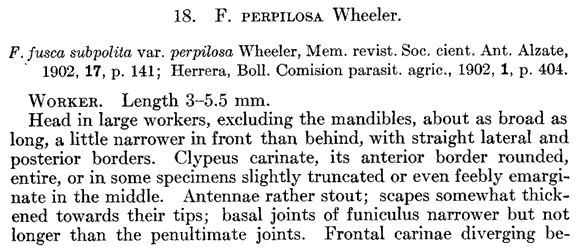
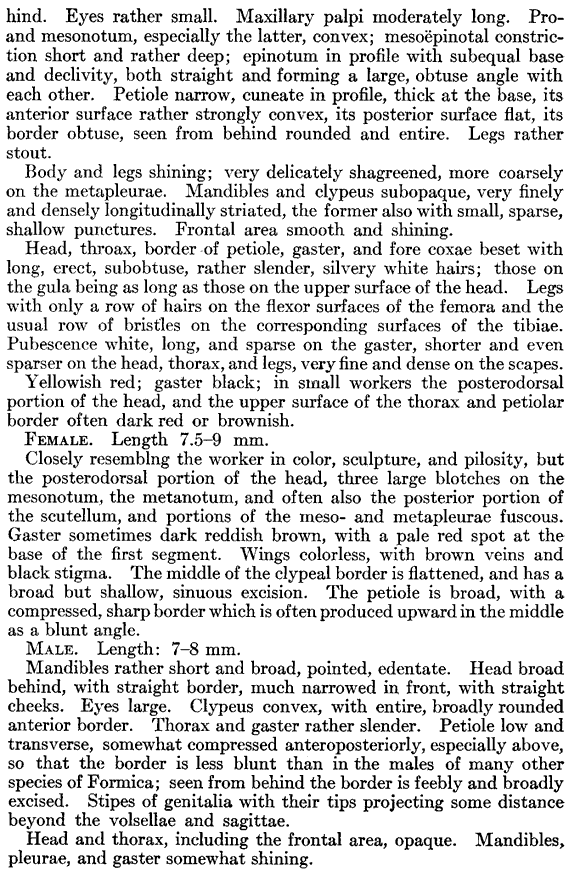

- Literature
- Brandão, C. R. F. 1979 (1978). Division of labor within the worker caste of Formica perpilosa Wheeler (Hymenoptera: Formicidae) collected near Portal, Arizona. Psyche. 85:229-237.
- Schumacher, A. and W. G. Whitford. 1974. The foraging ecology of two species of Chihuahuan desert ants: Formica perpilosa and Trachymyrmex smithi neomexicanus (Hymenoptera Formicidae). Insectes Sociaux. 21:317-330.
- Wagner, D. 1995. Pupation site choice of a North American lycaenid butterfly: the benefits of entering ant nests. Ecological Entomology. 20:384-392.
- Wheeler, W. M. 1902. Formica fusca Linn. subsp. subpolita Mayr, var. perpilosa, n. var. Memorias y Revista de la Sociedad Científica "Antonio Alzate". 17:141-142.
- Wheeler, W. M. 1913. A revision of the ants of the genus Formica (Linné) Mayr. Bulletin of the Museum of Comparative Zoology at Harvard University. 53:379-565.
- Whitford, W. G., C. A. Kay, and A. M. Schumacher. 1975. Water loss in Chihuahuan desert ants. Physiological Zoology. 48:390-397.
- A note about these publications. The literature cited here is not meant to be an exhaustive list of papers published about this species.
Page authored by David Lubertazzi and Gary Alpert
